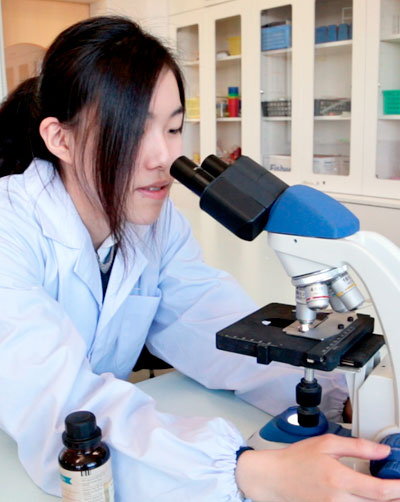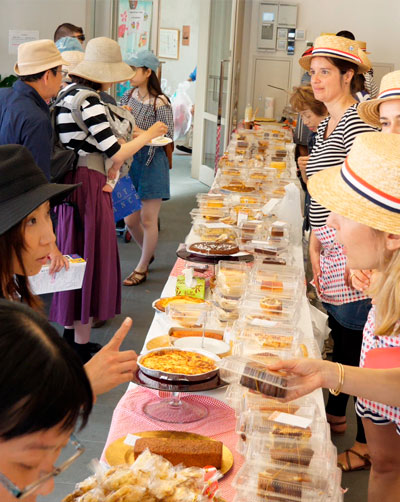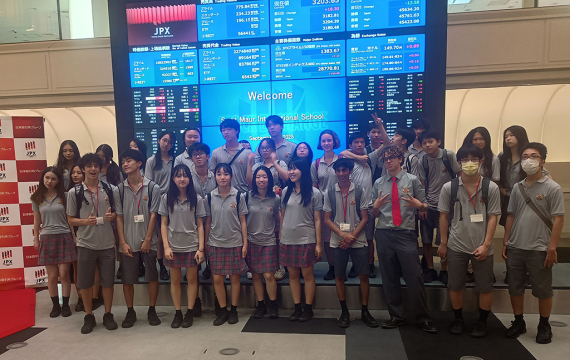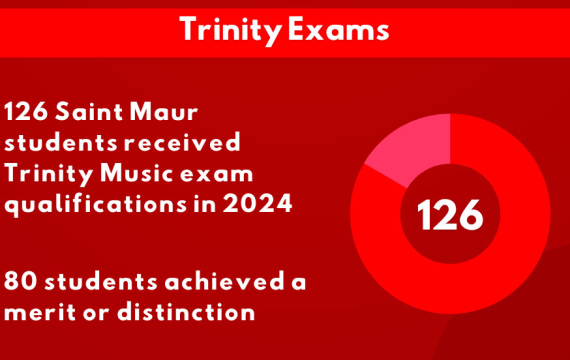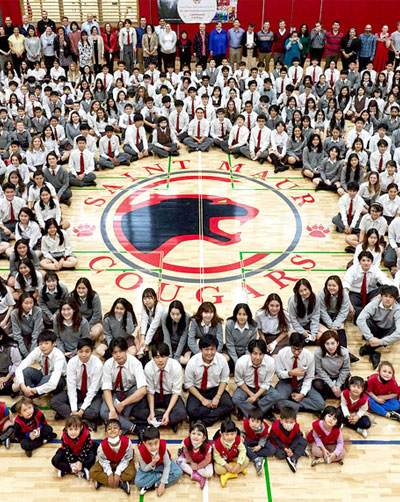
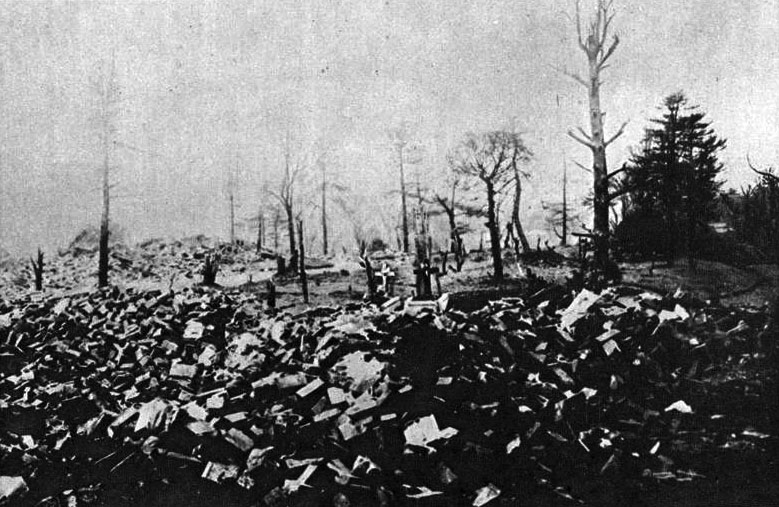
- Jeanette K. Thomas, MBE
- Social Studies
The 100th Year Commemoration of The Great Kanto Earthquake
Japan, as one of the countries within the Pacific Ring of Fire, experiences regular seismic activity throughout the year, causing earthquakes, tsunamis, and volcanic eruptions. Until the Great Eastern Japan Earthquake, which struck the Tohoku coast at 2:46 p.m. on March 11, 2011, the Great Kantō Earthquake of September 1, 1923 at 11:58, was the strongest earthquake ever to have taken place in Japan. While the latter registered 7.9 on the Richter scale, the Tohoku earthquake registered a magnitude of 9.1. Both caused devastating tsunami waves many meters high. While 140,000 lives were lost in the 1923 earthquake, the 2011 disaster saw almost 20,000 perish, with the tsunami accounting for 90% of deaths, and another 2,600 missing.
So many souls were lost during the Great Kanto Earthquake due to quickly moving fires, worsened by high winds, causing leaking gas pipes to ignite. More than two-thirds of the houses in Tokyo and Yokohama were burned down, leaving more than three million people homeless. The fewer deaths incurred during the Tohoku disaster can be attributed to the many lessons learnt from the Great Kanto Earthquake. Thanks to its development of one of the most advanced early warning systems in the world, and through ingenuity, creativity, and the significant investment made in overall infrastructure, including new building methods, architecture and engineering, Japan became better prepared for earthquakes and other natural disasters.
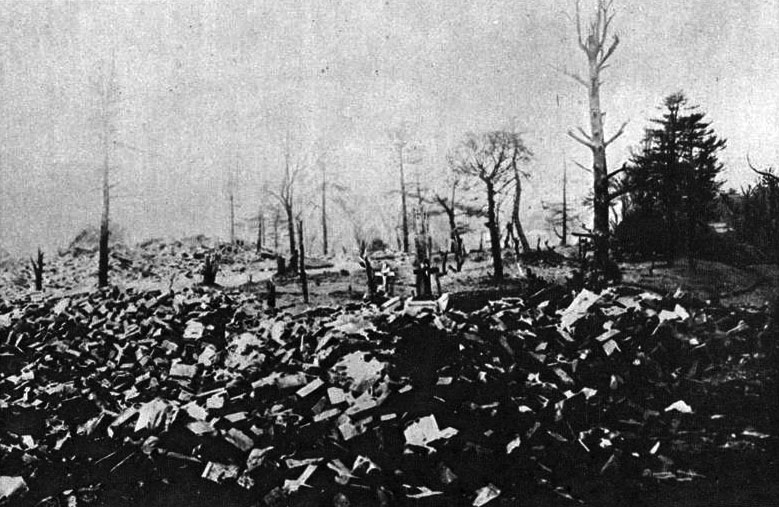
Saint Maur, established in 1872, after the Great Kanto Earthquake 'destroyed in 10 minutes'
Those who lived through the Great Kanto Earthquake did not have the benefit of sophisticated communication systems which existed in 2011, such as wi-fi or mobile phones. A lack of reliable and timely information resulted in a cacophony of misinformation, causing chaos and widespread panic. This in turn impacted on social order when unfounded rumors circulated, claiming that Korean immigrants were planning an uprising. Such rumors contributed to the Kanto Massacre in which, according to estimates, over 6,000 were killed: Koreans, Chinese, and Japanese mistaken as Koreans. However, both the Kanto and Tohoku earthquakes saw many unsung heroes courageously risk their lives to help others. In some cases, they lost their lives to prevent even bigger catastrophes from occurring. For example, during the Tohoku earthquake, brave individuals sacrificed themselves by staying inside the Fukushima Daiichi nuclear power plant during the disaster to stabilize the nuclear reactors.
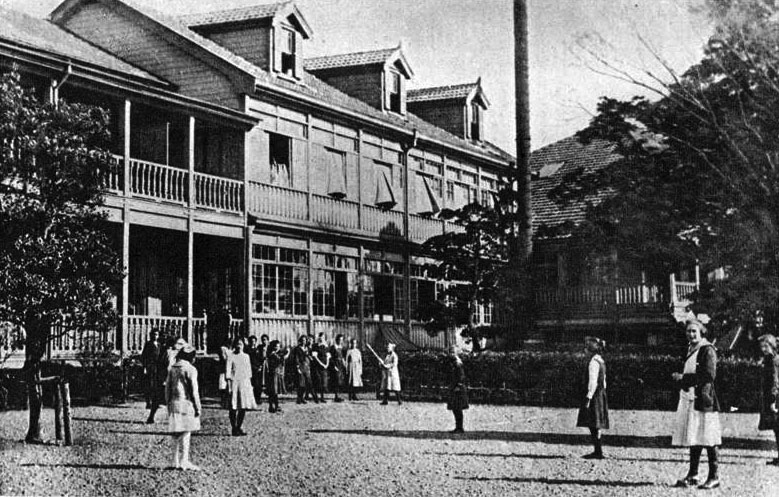
Saint Maur before the 1923 Great Kanto Earthquake
During its long 151-year history, Saint Maur International School contended with numerous disasters, natural and manmade. The resolve, resilience, and faith of the Sisters and the lay staff were tested on numerous occasions. However, nothing was more harrowing than the experience of having lived through the Great Kanto Earthquake, as evidenced in the personal testimonies of the events of September 1, 1923. The following excerpts are from the written memories of Sister Denis Twohig, an Infant Jesus Sister, born in Ireland in 1897, who came to Yokohama in 1920; and from an unnamed Saint Maur teacher, whose account of the Kanto earthquake was published on September 20, 1923, in The Japan Weekly Chronicle.
Sister Denis recalls, “on that memorable Saturday of September 1, 1923, it seemed as if a typhoon was gathering. A few minutes before noon, I went to the attic to hang up some freshly-washed linen, when suddenly there was a rumbling sound which grew louder. I ran back towards the attic door and was pitched out onto the staircase, the handrail of which pinned me down. For a while I did not realize what was happening but was confident that the other Sisters would come and find me. However, the tremors increased, and as I tried to release myself, I could see objects being flung around the attic as well as the sky and chimneys becoming visible. After sometime, I managed to get myself free and crawled through a big picture frame and eventually slid down closer to the garden area several feet below. Walking down below was a man whom I recognized as being the bookseller who delivered books to the school. I called out to him for help.
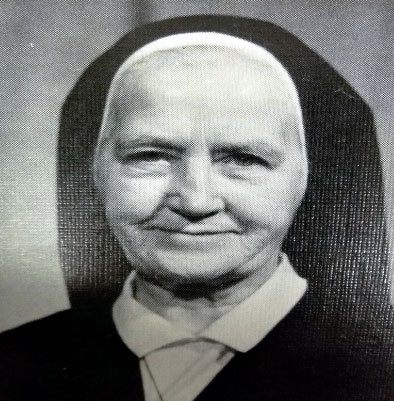 Sister Denis
Sister Denis
He was astonished to see me and in a matter of moments he made his way up the ruined building to rescue me.” Sister Denis shares her observations of the damage done to the chapel and the rest of the buildings and goes on to write: “After some time I saw Sister Xavier trying to shelter and comfort a group of orphans, and in the boarding school area, I found Sister Patrick O’Brien who was taking care of seven children in the boarding section who had remained in the school for the vacation while their parents were travelling. Most of them had been pinned under desks and beds that had fallen down from the floor overhead. They were crying frantically for help, and Sister was doing her utmost to comfort them, while at the same time praying for assistance. It eventually came, but not before six of her little flock had died. She was heartbroken and was never the same again.”
Sister Denis writes that, “The surviving Sisters, with the aid of some St. Joseph Marianist Brothers, did their best to rescue those who were trapped; however, because of the raging fires they were unable to rescue all, and eventually had to leave those trapped, knowing the awful fate of those left behind.” Although ten Sisters from the Yokohama convent perished, young Sister Enda Fitzgerald was one of the lucky ones rescued and consequently was able to continue her mission until her death at the age of 93. At her request, she was buried with the sisters who had perished during the earthquake. Their graves can be seen today in the Yokohama Foreign General Cemetery.
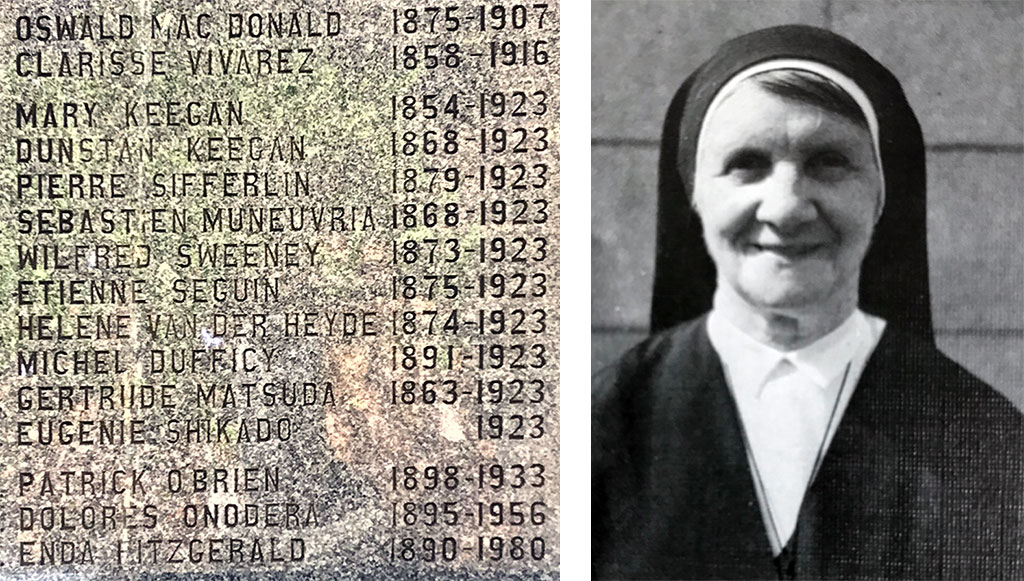
Gravestone at Yamate Foreign Cemetery & portrait of Sister Enda
The anonymous female teacher’s account published in The Japan Weekly Chronicle echoed the traumatic experience of Sister Denis. She writes, “We of the convent were early risers. At about 5:30 a.m. while at prayers, we noticed a slight earthquake, one of those little ones which we had been led to regard as a sort of seismic safety valve, but which were in fact a warning of the great catastrophe to come. It caused us no more than the usual mild concern and subsequent relief. At 11:58 a.m. the boarders of the foreign girls’ school (St. Maur), seven in number owing to the holidays, were in their recreation room in the charge of a Sister waiting for the tiffin bell, while most of the nuns were in the chapel. The Japanese orphans, some hundred all told, were mostly in th playground. I was in my quarters sewing when the shock took us all without warning.
“I put down my work and flew to the door with the intention of escaping down a flight of stairs into the garden. However, the violence of the motion threw me down them, and I was shot violently into the next building and buried in debris which pinned down my hand. Try as I might, I could not release my hand. I knew that the building was on fire and I prayed that something would fall and kill me before the flames reached me. When the second great shock hit us, miraculously the force of the movement enabled me to release my hand and dig myself out of the rubble.” She continues, writing that she joined the Sister who was with the foreign boarders; however, when it became evident that the building was about to collapse, the Sister instructed the students to follow her through the building towards the Japanese students’ quarters. Sadly, only one student made it, as the others went in another direction.” She continues to write, “We ran round to the side of the building where their voices could be heard screaming and sobbing and begging for help. They seemed to be uninjured, with the exception of one girl who kept crying, ‘I have a great stone on my chest, oh please take it off.’ Without more workmen and tools to move the debris, we were unable to get to them. All we could do was to offer comfort, prayers, and encouragement while waiting for help. As the flames of the raging fires threatened to surround us, it became a matter of saving ourselves or perishing with them, so we were sorrowfully obliged to abandon them to their fate.”
The author notes that “the Japanese orphans proportionately fared much better, although twenty of those little ones were lost. In all 36 members of our community in Japan perished, including eight European and two Japanese Sisters in Yokohama.”
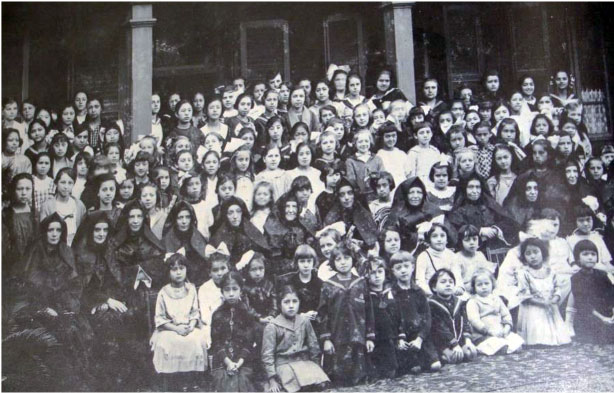
Saint Maur before 1919
On the following day, fires continued to burn out of control, so at 3:00 p.m. the police ordered all to make their way to the Bluff Gardens [now Yamate Park] situated behind the Sacred Heart Church. However, soon after having arrived, they were told to move on, as the fires were enflamed by strong winds and were rapidly approaching the area. The Sisters decided to make their way towards Negishi in the hope of later reaching Akobara, where the Sisters had a small house they often used for rest and recreation, up on the hills overlooking Isogo. One Sister set off walking to Akobara, while the others remained with the 30 children taking refuge on the veranda at the home of one of the Japanese teachers. The aftershocks continued for some time, leaving the children very traumatized. Since their early morning breakfast, their only meal had been one plum rice ball (umiboshi).
The next day a messenger brought word for the group to make their way to the Port near the French Consulate, where the French Ambassador welcomed them and handed out bananas, which were most welcome.
Later they boarded the crowded Andre Lebon vessel, where they remained for about a week while other refugees joined them. Ships from the U.S., England, and elsewhere arrived to assist and take people to Kobe, including 2,000 evacuated from China Town. The ship arrived in Kobe on September 9, where the Sisters were guests of the Sisters of the Child Jesus of Chauffailles. Eventually they were able to get a train to Shizuoka where they were able to join their own Infant Jesus Sisters at their Shizuoka convent and school.
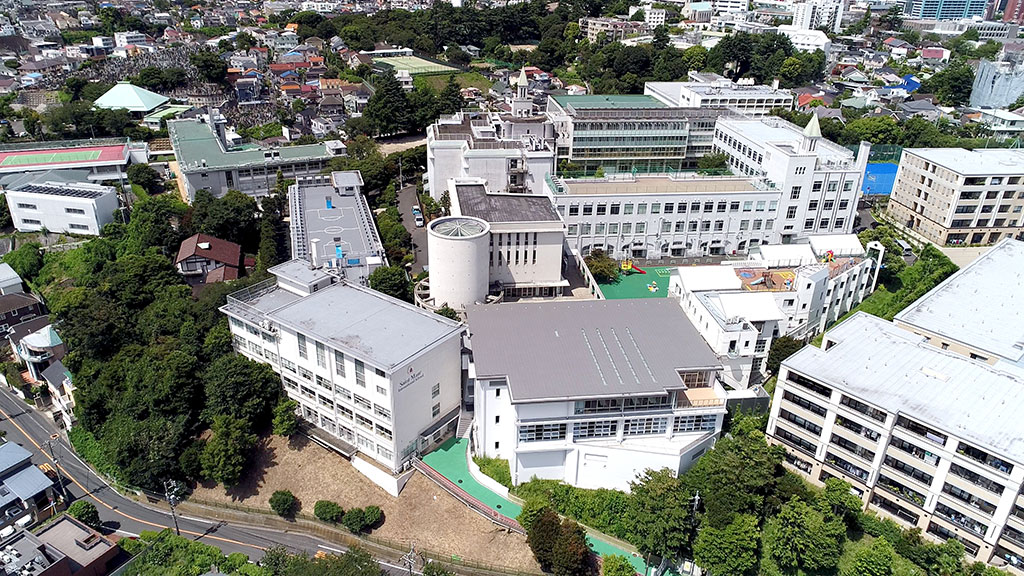
The Saint Maur International School Campus Today
Apart from the physical, emotional and psychological impact the Great Kanto Earthquake had on the people in Japan, the damage done to buildings, businesses, and the overall infrastructure was significant and estimated to have been in the region of 6.5 billion yen, four times more than the 1922 budget.
In all, twenty-six Infant Jesus Sisters, ten of whom were in Yokohama, were killed along with twenty-eight orphans and six boarders. With limited personnel and financial resources available, the Sisters restructured their work resulting in the orphanage Sumire and the boarding section of Saint Maur being closed. Thanks to the dedication of the Sisters and their continued faith in their mission, and with the support and efforts of the school and local community, both Saint Maur and Koran Jogakko, now Yokohama Futaba Gakuen, were rebuilt.
As we commemorate the 100th anniversary of the Great Kanto Earthquake and remember those who sadly perished, let us also give thanks to those who, through their ingenuity and skills, contributed to making Japan the safest earthquake-prone country in the world.
Jeanette K. Thomas, MBE
Former Music Teacher, School Head and Chairperson of the Board of Directors at Saint Maur International School from 1971 to 2023


